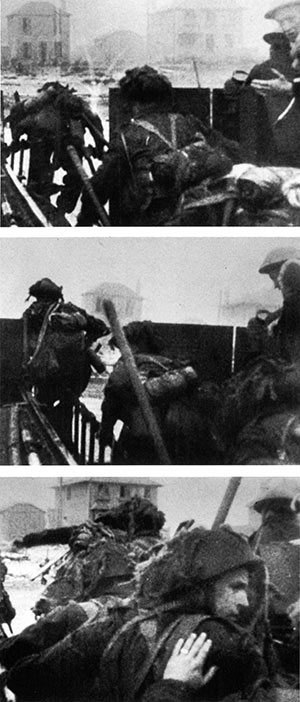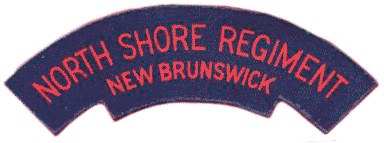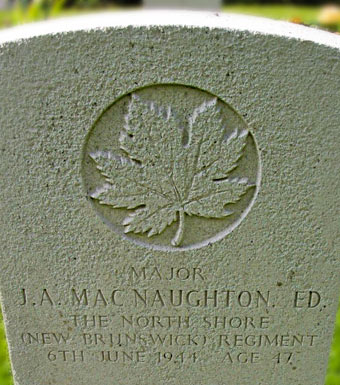D-Day — First Assault Wave
A Canadian Army in Hitler’s Europe
by Glenn Warner

Three frames of film footage from the Cdn Film & Photo Unit which has been inaccurately attributed to CFPU cinematographer Sgt Bill Grant. He did not shoot this footage of the North Shore Regiment landing in front of Les Hirondelles between Bernières-sur-mer and St-Aubin on the left flank of Juno Beach.
***
Looking at frame one, the house on the left still exists, as does the small middle house behind, but the house on the right was destroyed. Locals joke today that the small house now has an ocean view.
***
The platoon in this footage is most likely from 'A' Company which fought for control of this hamlet then linked up with the Queen's Own Rifles to their right before pushing inland. Note the new British P-1944 Mk III "Turtle" helmets, introduced shortly before D-Day to 3rd Division assault troops. It became known as the "Canadian helmet" though it was also distributed to British units.
H-Hour this rough grey morning, and the thirty-man Landing Craft Assault bounces through the choppy surf towards St-Aubin-sur-mer crammed with 7 Platoon, A Company, North Shore (New Brunswick) Regiment.
Platoon commander Lt. Fred Moar feels the bullets hiss by his ears as the stark silhouettes of houses loom larger. The boat shudders onward, rocked by heavy machine gun and mortar fire. Suddenly the ramp splashes down and the air comes alive, buzzing with fury.
Moar launches himself into the salt water and stumbles forward, laden with his 60 pound pack. The seawall grows bigger as he lumbers for cover, but out of the corners of his eyes, the shadows of men are collapsing around him. “Yard by yard you move in. Smoke up ahead, and the noise…it’s like nothing you’ve ever heard before, even in the blitz in England. What a difference between this and battle camp. Brother, this is for real.”
Wounded men lie strewn about, crying for their mothers. Those too injured to crawl further up on the beach are drowning in the rising tide, or in danger of getting run over by their own tanks which are arriving, late. In B Company, Cpl Leslie Clark leads his assault section looking to breach the wall and teem into the village. “We were told not to stop and help any of our buddies as we too might be hit.”
Clark finds a twenty foot gap and decides to risk booby traps and mines to press forward as sniper fire sprays his section with debris, inching hazardously closer. Pte. Sauvé gets hit just as they spill into the streets of St. Aubin, but he is left where he falls as they rush the first building. Other sections are now getting into town, and independently they begin the exhausting and treacherous task of houseclearing, ferreting out the enemy door by door, room by room, grenade by grenade. Bodies dart about, making it difficult to identify who is who — German, Canadian, civilian.
Crouching back at the sea wall, Lt. Moar meets up with his Platoon Sergeant, Ned Rigley, who also happens to be his brother-in-law. Rigley has come in on another landing craft and is sent off to assemble what is left of 7th Platoon while Moar sets off to track down their company commander. A bangalore torpedo blows a hole in some wire entanglements and Moar follows a Flail tank through a minefield onto the main stretch of town.
The reserve companies, C and D, have landed on Juno now, and the New Brunswickers are snaking their way through the buildings of St. Aubin. Some German soldiers submit with the wave of a handkerchief, while others are bitterly defiant. Numbers of German prisoners are trickling past Moar now down to the beach. A French woman, tears falling down her cheeks, emerges from a storefront, asking Moar, "How long will you be staying?"

Shoulder flash worn by the soldiers in the film footage above which helped MLU identify the Canadian unit from 3rd Division as the NSR.
Moar comes across his A Company Commander Major McNaughton on the edge of town. With the reserve companies taking over the mop-up operations, McNaughton’s company is re-assembling for a thrust inland, but they are drawing fire from a nearby copse. McNaughton orders Moar to take it out, so Moar heads back to the sea wall to collect Rigley and the rest of his platoon. A huge explosion rocks Moar off his feet as he steps onto a path, stunning him and killing the man from Chatham next to him. Moar shakes off his cobwebs, and as his men pick him up, they also informed him his platoon sergeant and brother-in-law, Ned Rigley, has been killed by a sniper.

As Moar’s North Shore men attack the copse they come under heavy fire. But a Sherman tank of the Fort Garry Horse appears on their flank and they direct fire into the copse. Suddenly Germans are yelling “I surrender” and the North Shores quickly move in to mop up and send the enemy prisoners back to battalion headquarters on the beach.
As they move onto their next objective near Tailleville, a runner appears, informing Lt. Moar that his A Company commander, Major McNaughton, has also been killed. 7th Platoon commander Lt. Moar is to report back to company headquarters.
Moar makes his way, in line with the long stream of German POWs, back to Juno beach.
And the longest day is only a few hours old.
(With files from the Government of New Brunswick website (www.gnb.ca)
and New Brunswick School Board site.)
*****
The story of D-Day & Normandy continues next page. ![]()
If you have any observations, comments, insights, or see any errata, typos please Contact Us.






